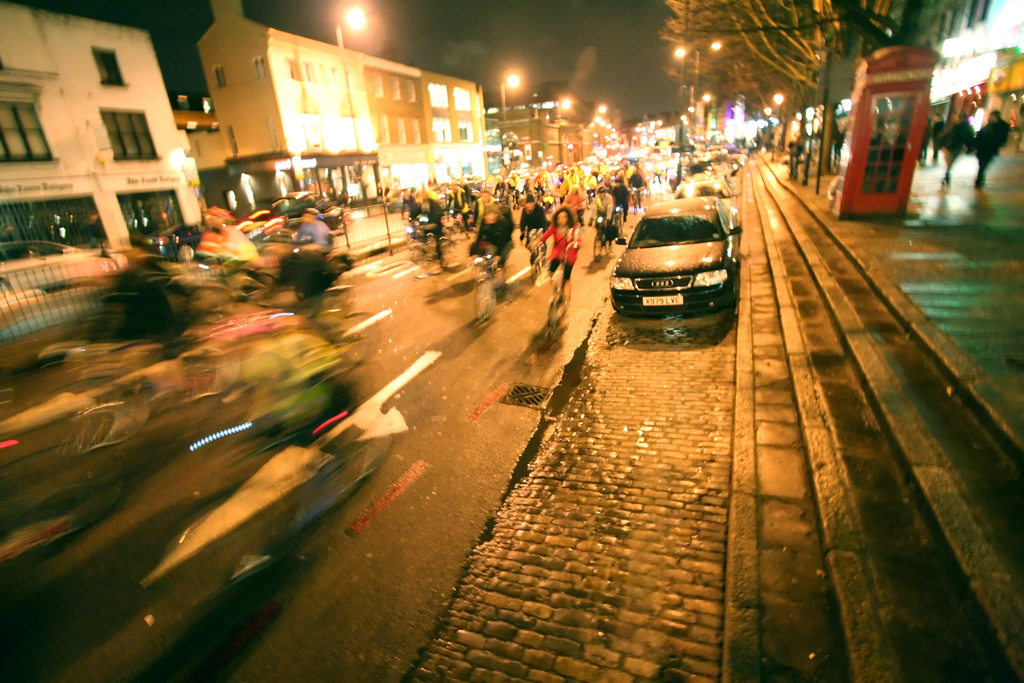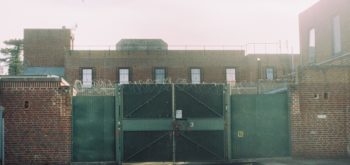An interesting video surfaced this week from the place where all interesting videos surface – Youtube from last Friday’s Critical Mass demonstration in London, writes Mike Etienne. Photo by biggerbyfar (Critical Mass ride in February 2007, Upper St, London).
On a night when anywhere between 130 and 182 people were arrested, an unidentified woman challenges an officer (‘Sergeant Sefer’ in the video), as members of the ride explain to the officer that a man being detained off camera needs water to deal with the effects of a 19 hour cycle during Ramadan. The sergeant however, appears not to share her concern and disappointingly, though not altogether surprisingly, he demonstrates little short of contempt.
- You can read more about the ride and arrests in the Guardian HERE.
The operation by the Metropolitan police was aimed at halting about 200 cyclists on the monthly Critical Mass bike ride from travelling in and around the Olympic Route Network as Danny Boyle’s “Isles of Wonder” opening spectacle unfolded.
Guardian
Who are Critical Mass? Well, in their own words, they don’t really know:
Indeed, it is a measure of their inherently disorganised nature that they also have no designated organiser and the route they follow is determined on a ‘follow-the-leader’ basis, set by the person who happens to be leading the procession at any given time.
What the participants do do is cycle en masse, usually from the same starting point in London on the same date every month, as they have done since 1994. It would also be fair to say that some, but not necessarily all, of the participants join in the ride to raise awareness of a particular cause or issue. As a demonstration, Critical Mass probably works because their sheer weight of numbers slows the traffic and when you sat in the middle of central London with nowhere to go, there’s not much else to look at.
In an exchange that will do little to improve the battered reputation of the Met Police (after renewed controversy over paying police for information and ongoing allegations of institutional racism), the officer bluntly dismisses the female cyclist. He, however, explains he does know the law and ‘could quote PACE to you [and] could quote cases’ but then declines the chance to demonstrate that knowledge. Instead he tells the woman that she will be arrested for breaching section 12 of the Public Order Act 1986 – failing to comply with the conditions under which the ride was allowed to take place. That section creates two offences, making an organiser and a participant each potentially liable for a failure to comply with conditions.
It is not clear whether the cyclist was indeed among those arrested. A more immediate question is why, if the officer was satisfied that an offence had been committed, he did not arrest the cyclist at that point. Also, why he is prepared to wait for another officer to do so and why does the threat only come after his authority is challenged?
Olympic legacy
The sergeant is of course right that he has responsibility for ensuring the care of an arrested person in the first instance. That is why an officer also has an obligation to deliver an arrested person to a police station as soon as possible. After that, it is the custody officer who then becomes responsible for protecting the arrested persons.
It is also clear from PACE that an officer should be prepared to be challenged in the exercise of his powers and that he or she should be able to explain the legal basis on which those powers are used, that is the whole point of the PACE regime:
Officers should embrace a sense of transparency and reasoned engagement with the public. It is as important for protecting them in their work as it is for the public in their ability to resist the perceived excesses of coercive power. In the context of free speech and the right to protest, these considerations can only grow in importance.
A police spokesman told the Guardian:
That misses the point. There is a balance to be struck between competing interests. If the concept of protest is reduced to protecting only what is convenient to wider society then, what’s the point?
It might not be what Seb Coe and the BOC had in mind when they were conceiving their vision of an Olympic legacy but with charges now having been brought and some fundamental issues still left unsettled, we have not reached the end of the road with this one just yet.
- Mike Etienne has just been called to the Bar and hopes to focus on public law and human rights. He is a Cassel Scholar and Sir Peter Duffy Award winner of Lincoln’s Inn and will undertake an internship at the European Court of Human Rights in October.








A detailed critique of the Court of Appeal judgment in the case of Oliver Campbell